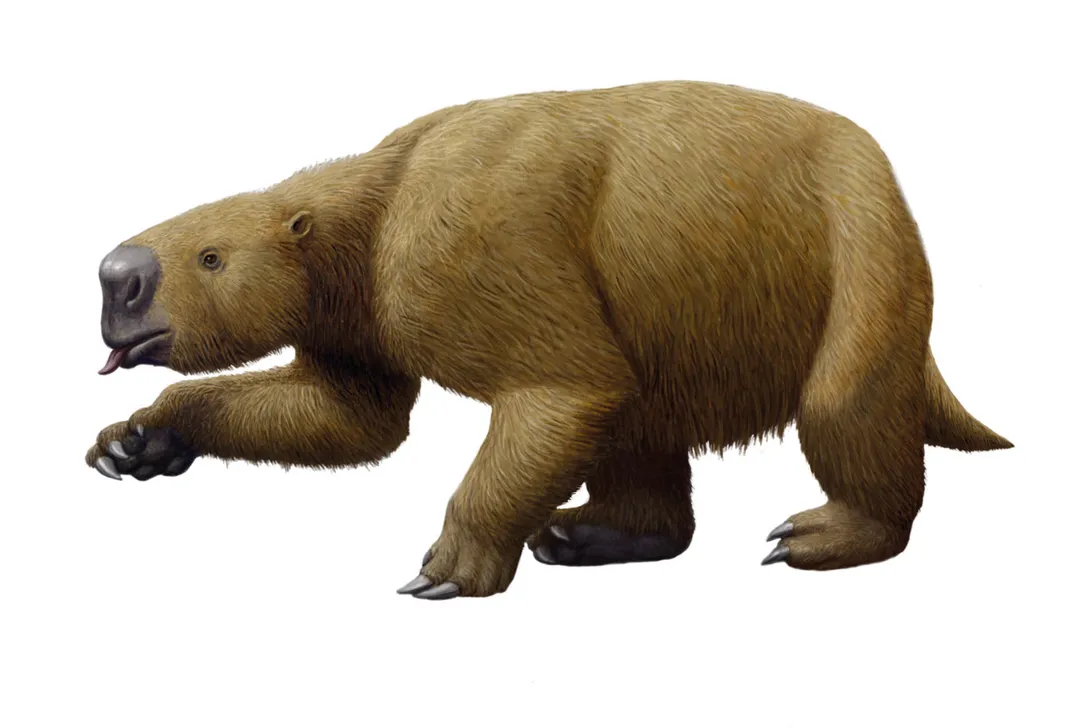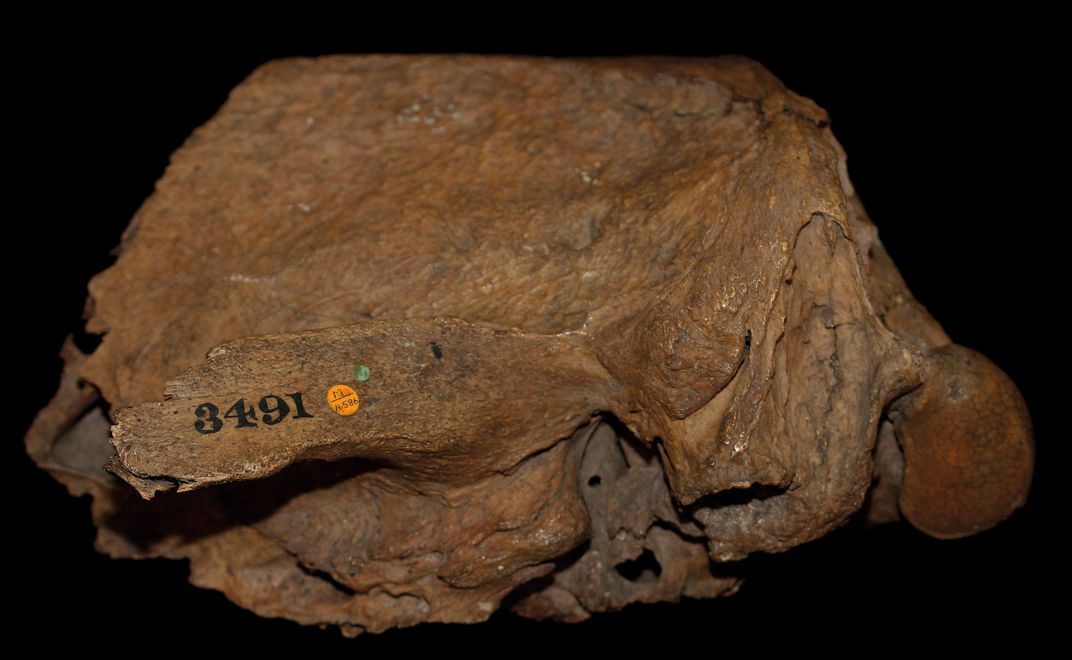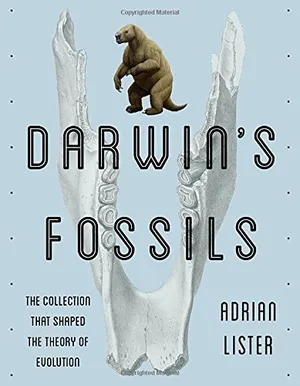How Darwin’s Theory of Evolution Evolved
A new Smithsonian Book highlights firsthand accounts, diaries, letters and notebooks from aboard the HMS Beagle
:focal(1039x475:1040x476)/https://tf-cmsv2-smithsonianmag-media.s3.amazonaws.com/filer/f4/9e/f49e5ab6-c293-4dd0-b40f-f99dfc990e86/sia-sia2008-0862.jpg)
The skulls and bones of extinct mammals were the crowning glory of Charles Darwin’s fossil collecting in South America, not only for him but for the eager recipients of the cargoes he sent home. They were the discoveries that made his name known beyond his immediate circle.
When the first consignment of fossil bones arrived at the Royal College of Surgeons in 1833, the puzzled curator, William Clift, recorded them as apparently “from a Mr Darwin at Rio de la Plata.” Only a few months later, however, after the specimens had been exhibited in Cambridge, Darwin's friend Frederick William Hope wrote to tell him that his “name was in every mouth.” Even more significantly, Darwin later credited the fossil mammals as one of the two main factors that led him to embrace the reality of evolution.
**********
The most complete fossil of any mammal discovered by Darwin was an almost entire skeleton, later recognized as another new species of ground sloth by Richard Owen, a professor at the Royal College of Surgeons who described and named Darwin's fossils. It appears to have been found on the beach, partially embedded in loose sand, and Darwin concluded that the whole mass had fallen from the cliff.
The skeleton comprised the skull, vertebral column, ribs and limb bones down to the claws, “all nearly in their proper relative positions,” including even the kneecaps. This remarkable discovery was first noted by Darwin on September 1, 1833, and must have been made at some point during his second phase of collecting at Punta Alta, Argentina, the previous week.
/https://tf-cmsv2-smithsonianmag-media.s3.amazonaws.com/filer/7e/56/7e566e6e-6ca1-4ca4-9189-e2ee2672849d/scelidotherium-colour-version-2.jpg)
Darwin quickly recognized the significance of finding an articulated skeleton; whereas odd bones might have been washed out of earlier deposits or fallen in from above, a complete skeleton embedded in sand demonstrated conclusively the contemporaneity of the living animal with the ancient deposit in which it was found. “Gran bestia all nonsense,” he exclaimed in his notebook, referring to a local legend, for it was perfectly clear that the remains were ancient and not those of a mysterious creature that still roamed the Pampas.
He wrote to his sister Caroline that he had discovered the skeleton of an animal “of which I do not think there exists at present on the globe any relation.” Later he wondered if it might represent the same species as the mandible whose four teeth he had previously illustrated, subsequently named Mylodon darwinii. On detailed comparison, however, Owen confirmed it as a different genus, smaller and with a more elongate skull, and named it Scelidotherium leptocephalum.
Another sloth species discovered by Darwin was found in November 1833 during his two-week excursion across present-day Uruguay. It was part of the back of a skull, later named Glossotherium by Owen. The find was made in the same stream, the Sarandi, where a larger, more complete skull of the celebrated mammal Toxodon had been discovered. It is not quite clear whether Darwin himself found the Glossotherium specimen at the stream, or obtained it from the finder together with the Toxodon, although the former seems more likely. At any event the specimen, which Darwin described as from “an animal rather larger than the horse,” was remarkable for its superb state of preservation; he wrote that it appeared “so fresh that it was difficult to believe [it had] lain buried for ages under ground.”

Darwin's Fossils: The Collection That Shaped the Theory of Evolution
Richly illustrated with photos from the fossil collection and line drawings produced when Darwin was alive, Lister’s work is an essential acquisition for every library prizing quality books on evolution.
Not only was the appearance of the bone fresher than any of his other fossil finds, it preserved delicate parts that are usually broken away in ancient remains. This included the tympanic bone, one of the tiny ear bones. Its preservation in place in the skull lead Owen to praise “the care and attention devoted to his specimens by their gifted discoverer.”
Darwin wanted to know more. He held a piece of the bone in the flame of a spirit-lamp, finding that it not only burnt with a small flame, but “exhaled a very strong animal odour.” He sent a piece to Trenham Reeks at the Museum of Economic Geology in London, who had undertaken chemical analyses of several of his rock samples, asking what percentage of animal matter it contained. By this he meant organic material aside from bone mineral, and the answer was 7 percent. We would now recognize that around a quarter of the original protein content had been retained. The remarkable state of preservation of this skull, and its different appearance from others in Darwin’s collection, make it very likely to have fallen from a higher, later level in the river bank than the Toxodon and glyptodont remains found nearby.
Having only a fragment of skull at his disposal, Owen was characteristically cautious and identified it as an edentate without specifying to which group it belonged. A large attachment surface for the bone supporting the tongue, and a wide hole for the nerve supplying the latter, led him to reconstruct a very large tongue and to devise the name Glossotherium (tongue-beast). He later abandoned the name, considering the skull to belong the same species as the jaw that he had named Mylodon darwinii.
It is now recognized as being distinct, however, so Owen’s name has been reinstated and the species is known as Glossotherium robustum. Owen considered the animal might have been an insect-eater, breaking open termite nests like an anteater, but it is now known to have been herbivorous in its habits. Its wide muzzle suggests unselective bulk-feeding on grasses and low-growing herbs.

In 2017, based on collagen protein extracted from Darwin's Glossotherium skull, a radiocarbon date of around 12,660 years ago was obtained. This is one of the latest known records of the genus, close to the time of its extinction. Glossotherium robustum had an estimated body weight of around 1.5 tonnes [1 ton U.S.].
In spite of this, a remarkable recent suggestion is that Glossotherium and/or Scelidotherium may have constructed large burrows to escape predation or unfavorable weather. Several lines of evidence support this idea. First, several large “fossil burrows” have been discovered, especially in the area around Buenos Aires, their diameter of 3 to 4.5 feet matches the body width of these species. Second, the forelimb bones of these animals appear modified for very powerful movements like digging. Third, claw marks have been found on the inside of some of the burrows, forming pairs of grooves that match closely the claws of the large second and third digits seen in these species. These sloths would be by far the largest animals known to burrow in this way—and one of the fossil burrows is more than 130 feet in length.
Darwin’s discovery on this journey of four genera of large ground sloths, Mylodon, Glossotherium, Scelidotherium and Megatherium was remarkable, and also serendipitous in that the area in which he was collecting happened to be the only region where all four could have been found together. Mylodon is distributed in the southern half of the continent, Glossotherium in the northern half, and Scelidotherium in the middle. The genus Megatherium is widespread, but M. americanum is known mainly from Argentina. Only in the Pampas region and La Plata basin do they overlap. The differing forms of their skulls, and teeth and limbs show how several species could have co-existed in the Late Pleistocene, using different food and habitat resources.
For Darwin, the relationship of the extinct giant sloths to the living species was one of the examples that led him to his “law of succession of types,” whereby there was an affinity between the past and present inhabitants of a particular region (in this case South America). This general pattern was one of the key factors that ultimately persuaded him of the reality of evolution.
Darwin’s Fossils: Discoveries that Shaped the Theory of Evolution by Adrian Lister, a research leader in the earth science department at the Natural History Museum, London, is published by Smithsonian Books.
A Note to our Readers
Smithsonian magazine participates in affiliate link advertising programs. If you purchase an item through these links, we receive a commission.
